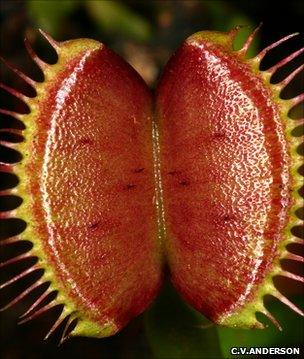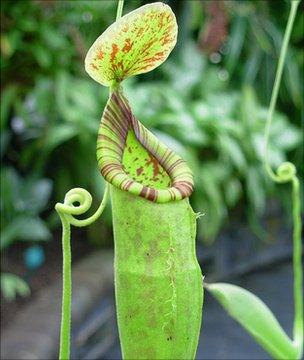Collectors threaten world's carnivorous plants
- Published

The Venus flytrap, one of the best known carnivorous plants, is listed as Vulnerable
The collection of specimens from the wild is one of the main threats facing the world's carnivorous plants, a study has recorded.
It found that the most common threat was habitat loss, while other factors that threatened the plants included invasive species and pollution.
Half of the meat-eating plant species that had been assessed were listed as threatened, the research observed.
The findings will appear in the journal Biological Conservation., external
Co-author David Jennings, a researcher from the University of South Florida, US, said he had been quite surprised to see overzealous collectors listed as a such a threat, especially as a growing number of places were monitoring poaching behaviour.
"But it is still a problem because many of these species are fairly slow growing," he told BBC News.
"Even though there are good alternatives, such as growing them in greenhouses or labs, people who are after a quick fix will just go out and take them because it can take several years for the plants to reach a decent size."
He added that carnivorous plants were targeted more than any other taxa, probably as a result of the plants' exotic appearance.
"It is pretty safe to say that they are one of the most charismatic group of plants - one of the reasons why they interest me is because they are quirky, intriguing and capture their prey."
Biologists suggest that the plants evolved the ability to capture prey as a way to adapt to living in moist, nutrient-poor soils.
Usual suspects
Loss of habitat is, unsurprisingly, the main threat to the plants.

A number of carnivorous plants, such as pitchers, support a range of other species within ecosystems
"The habitats that the plants are found in are quite easily disturbed," Mr Jennings explained.
"A lot of these areas get drained and used for agricultural land and farming. Any sort of change in the water-table can really affect them."
He added that a number of species, especially pitcher plants found in South-East Asia, had a very limited distribution and were only found over a small area - for example, the foothills of just a few mountains.
"Many of them have very restricted ranges, which is why we think that many of them are found on the IUCN's endangered list."
Across the globe, there are about 600 known species of carnivorous plants, spread across 17 genera.
Writing in their paper, the researchers said that out of the 107 species to have been assessed by the International Union for Conservation of Nature (IUCN), seven were listed as Critically Endangered; 11 Endangered, and a further 39 were listed as Vulnerable.
For their study, Mr Jennings and co-author Professor Jason Rohr gathered data on 48 species from nine genera.
When they examined the data collection, they said that they were surprised that pollution was considered to be such a problem for the plants.
"Habitat loss was not really that surprising because it is a major threat for many species, but pollution was quite surprising because it seems to have been listed as a threat without a lot of empirical evidence at this point," Mr Jennings said.
They found that 18 of the 48 species in their study were affected by pollution, such as urban waste, fertiliser and pesticide run-off.
"Some forms of pollution (such as herbicides) can be lethal to carnivorous plants directly, while other forms (such as nutrient additions) have a more indirect effect by degrading the habitat and making conditions more conducive for other plants," they explained.
Mr Jennings said that, as a group, carnivorous plants had been generally overlooked and more research and analysis was required, especially Africa and Australia, when there were very few records.
"We found next to nothing in terms of documentation for these regions, if though they are really diverse areas in terms of carnivorous plant species."
- Published12 May 2010